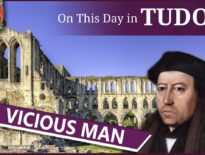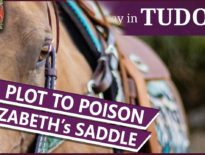On this day in Tudor history, 24th November 1572, John Knox, the Scottish clergyman, famous Reformer , royal chaplain, and founder of Presbyterianism, died at his home in Edinburgh as his second wife, Margaret, read aloud from Paul’s First Letter to the Corinthians.
John Knox is known for bringing the Protestant reformation to the church in Scotland and his controversial views about women rulers, but he was also chaplain to King Edward VI and had a very eventful life, being taken prisoner by the French and being forced into service on the galleys of their fleet at one point.
Find out more about John Knox's life and career in today's talk.
The Works of John Knox can be read online at Archive.org - https://archive.org/search.php?query=works%20of%20john%20knox
July 20 - John Knox's attack on Mary I:
Also on this day in Tudor history, Saturday 24th November 1487, the coronation procession of Elizabeth of York, queen consort of King Henry VII, the first Tudor monarch, took place in London.
Elizabeth of York's coronation was scheduled for the next day. She had become queen in January 1486, but her coronation had been postponed due to pregnancy and trouble with the Cornish rebels and Perkin Warbeck. Finally, Henry VII's wife and the mother of little Prince Arthur could be crowned queen. Find out all about her coronation procession, what Elizabeth wore, who was involved and what happened, in last year’s video:
Also on this day in history:
- 1534 – Death of Sir Thomas Wriothesley, herald and father of the Tudor chronicler Charles Wriothesley. It is thought that he was buried at the family church, St Giles Cripplegate, in London.
- 1542 – The Battle of Solway Moss between England and Scotland. The battle took place on Solway Moss, a moss or peat bog in Cumbria near the Scottish border. The Scottish troops were led by Robert, Lord Maxwell, and the English troops by Sir Thomas Warton. The Scots were forced to surrender after they found themselves trapped between the River Ersk and the moss. Many drowned.
- 1550 – Burial of Sir James Wilford, soldier and commander at Haddington during the War of the Rough Wooing, at St Bartholomew by the Exchange. Bible translator Miles Coverdale preached at the service.
- 1559 – Death of Thomas Raynold, Dean of Exeter and nominee for the bishopric of Hereford. Mary I's death and the accession of Elizabeth I put a stop to him being consecrated as bishop, and he died in Marshalsea prison after refusing the “Oath of Supremacy”. He was buried in St Margaret's Church, Westminster.
- 1587 – Death of Sir William Pelham, soldier and Lord Justice of Ireland, shortly after landing at Flushing in the Netherlands with reinforcements. He had been shot in the stomach in August 1586 at Doesburg while shielding Robert Dudley, Earl of Leicester and his commander in chief, and returned to England in April 1587 to take the waters at Bath. He felt well enough to return to the Netherlands in November 1587, but it was too much for him.
- 1598 – Death of William Paulet, 3rd Marquis of Winchester, nobleman and author, at Basing in Hampshire. He was buried there. Paulet was made a Knight of the Bath at Mary I’s coronation in 1553, and his offices during the reigns of Mary I and Elizabeth included High Sheriff of Hampshire, Commissioner for Musters, Joint Lord Lieutenant of Hampshire, Lord Lieutenant of Dorset and a commissioner at the trial of Mary, Queen of Scots. He was also the author of the 1586 “The Lord Marques Idlenes”, which was dedicated to Elizabeth I, and was described as “containing manifold matters of acceptable advice; as sage sentences, prudent precepts, morall examples, sweete similitudes, proper comparisons, and other remembrances of speciall choice”.
Transcript:
On this day in Tudor history, 24th November 1572, the Scottish clergyman, famous Reformer , royal chaplain, and founder of Presbyterianism, John Knox, died at his home in Edinburgh as his wife read aloud from Paul’s First Letter to the Corinthians. He was buried in the cemetery of St Giles’ Cathedral, Edinburgh, where he had served as minister. Knox is known for bringing the Protestant reformation to the church in Scotland.
Let me tell you a bit more about this Scottish clergyman in today’s talk, which is based on an extract from my book “On This Day in Tudor History”.
John Knox was born in around 1514 at Giffordgate in Haddington, and he was the son of William Knox, whose family had served the Earls of Bothwell for many years. His mother’s maiden name was Sinclair, a name that Knox used when he needed to go into hiding.
Knox studied at St Andrews University under John Mair before entering the Church, becoming ordained in the late 1530s.
It is not known when Knox became a Protestant, but he was good friends with George Wishart, who was burned at the stake for his Protestant faith in 1546. Knox went into hiding following Wishart’s execution as he was known to be friends with the martyr. Knox was also influenced by Heinrich Bullinger and John Calvin, whom he met while in exile in Geneva during Mary I's reign.
Although Knox is linked primarily with Scotland, he ended up spending a few years in England following his forced service on the galleys of a French fleet which captured St Andrew’s Castle, where he was chaplain, in 1547. He was released in February 1549 and took refuge in England, where Edward VI was on the throne. He settled in Berwick-upon-Tweed, preaching there for two years, and it is thought that he met his wife, Marjory Bowes, at this time, becoming betrothed to her. Margaret was the daughter of Robert Bowes, captain of Norham Castle.
In 1551, he moved to Newcastle, preaching at the Church of St Nicholas, before moving on to London and working as a royal chaplain and preaching in front of King Edward VI. Knox refused the office of Bishop of Rochester, seeing it as a political office, and also refused the living of All Hallows, Bread Street in London, which would have put him under the Bishop of London’s authority. He kept his post of royal chaplain and was sent to the counties of Buckinghamshire and Kent to preach in June 1553.
Following the death of his king and the accession of the Catholic Mary I, Knox chose to stay away from London and travelled north. He then decided that it was safer to go into exile. He spent time in Geneva and Frankfurt, before heading to Scotland to marry his fiancée, Marjory. It is thought that the couple married in 1556. They had two sons before Marjory died in 1560.
On his return to Scotland, Knox toured the country, preaching to underground churches. He was called to Edinburgh in May 1556 to answer charges of heresy, but he was accompanied by so many important supporters, that a trial did not go ahead. In September 1556, he went into exile once more in Geneva, where he had been elected as a minister. This time, he was accompanied by his wife and her mother. His and Marjory’s two sons were born there in 1557 and 1558, and Knox enjoyed his time in Switzerland preaching to his congregation and writing.
At Mary I’s death in November 1558, many of the exiles in Geneva headed back to England, and in January 1559, Knox chose to travel to Scotland, not being welcome in England following the publication in 1558 of his work, “The First Blast of the Trumpet Against the Monstrous Regimen of Women”, in which he attacked women rulers. Elizabeth I was not impressed. He landed at Leith in May 1559 and became minister at St Andrews in autumn 1559.
In early August 1560, Knox was involved in drawing up the Scots Confession, which was approved by Parliament who also abolished the jurisdiction of the Pope in Scotland, forbade the celebration of mass, condemned doctrine and practice which did not adhere to the reformed faith, and asked Knox and other Reformist ministers to organise the new Scottish Kirk (church). Knox and his fellow ministers drew up the “Book of Discipline”, but Parliament delayed over ruling on it because Mary, Queen of Scots was due to come back to Scotland. Over the next three years, Knox was summoned into Mary's presence five times, accused of inciting rebellion and speaking against her. He was lucky to escape charges of treason.
In December 1560, Knox’s wife Marjory died and in March 1564 fifty-year-old Knox married 17-year-old Margaret Stewart, daughter of his friend, Andrew Stewart, 2nd Lord Ochiltree. The marriage was very happy, with Margaret acting as his secretary. The couple had three daughters together.
After Lord Darnley’s Protestant supporters murdered Mary’s secretary, David Rizzio, in March 1566, Knox fled to Kyle in Ayrshire where he worked on his “History of the Reformation in Scotland”. Darnley’s subsequent murder and Mary’s marriage to Bothwell, the chief suspect in Darnley’s murder, led to divisions in the Protestant nobles as they tried to figure out what to do. Mary was eventually forced to abdicate and was imprisoned in Loch Leven Castle, while James Stewart acted as regent for Mary’s infant son, James VI. On 29th July 1567, John Knox preached in Stirling at the coronation of James VI, and started preaching against Mary, even pushing for her execution. On 23rd January 1570, James Stewart was assassinated, and his successor, Matthew Stewart, 4th Earl of Lennox, was shot dead a year later. On 30th April 1571, all enemies of the Queen were ordered by the controller of Edinburgh to leave the city. However, Knox knew the controller, and so was offered the option of staying in Edinburgh as a captive in the castle. Knox refused this offer and left the city on the 5th May to travel to St Andrews. After the truce of July 1572, he was able to return to Edinburgh and he preached there, at St Giles, until his death at 11pm on 24th November 1572. His wife Margaret nursed him through his final illness and Knox made his will in May 1572, naming Margaret and their daughters as executors. Margaret read to him from the New Testament as he lay dying, reading Paul’s first letter to the Corinthians.. Knox was laid to rest in the churchyard of St Giles’ in Edinburgh in a funeral attended by Scotland’s new regent, James Douglas, 4th Earl of Morton.
Knox's works include the 1555 “A Faithful Admonition unto the Professors of God’s Truth in England”, which was an attack on the Catholic Mary I and her regime. I’ll give you a link to my video on that work, so you can find out more, but in it he called Mary an “incestuous bastard”, for turning England away from the Protestant faith, and stated that she was worse than Jezebel. He also wrote the famous 1558 “The First Blast of the Trumpet Against the Monstrous Regimen of Women”, which I mentioned earlier, in which he attacked women rulers such as Mary I and Mary of Guise. His other works include his five-volume work “The History of the Reformation in Scotland”, which he wrote between 1559 and 1566.



Leave a Reply